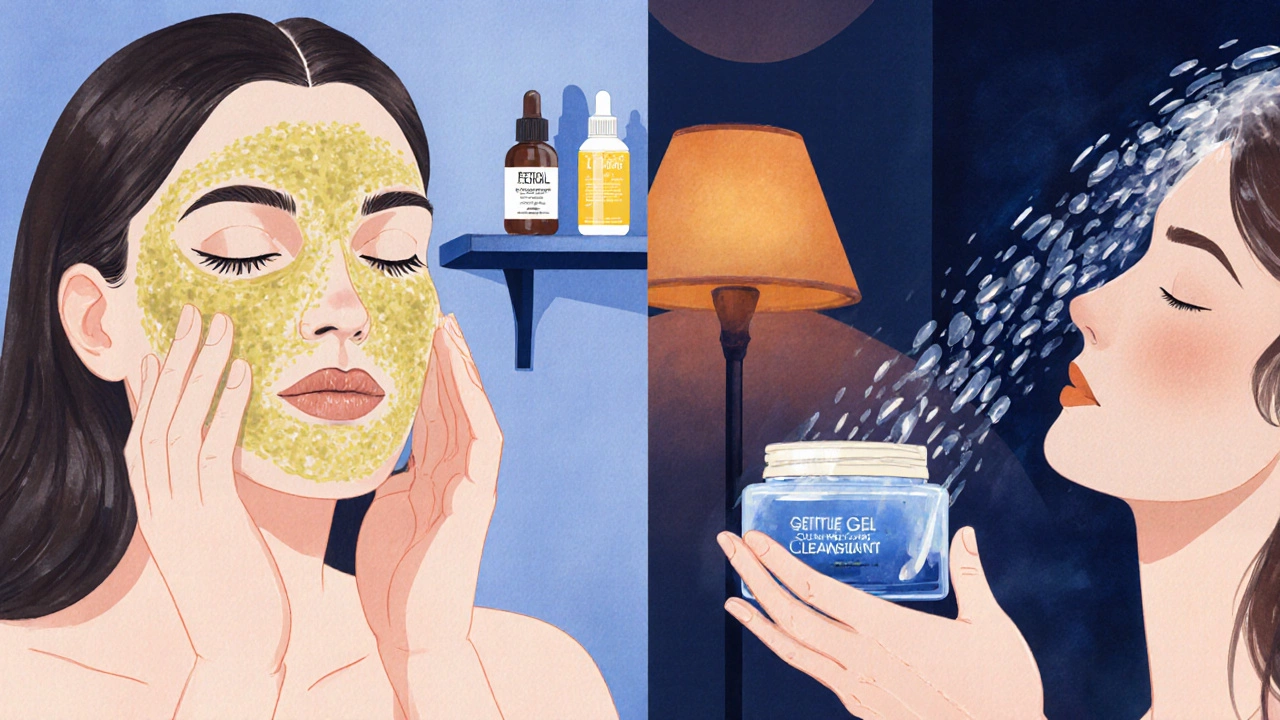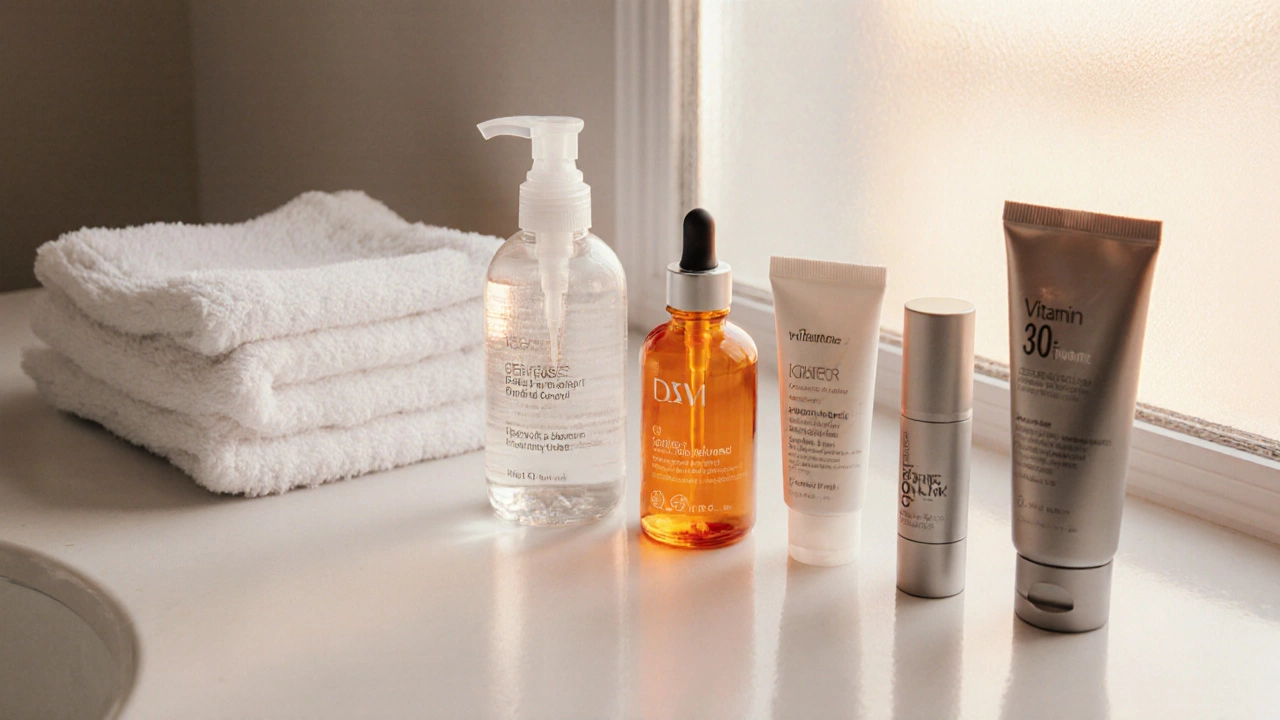Sunscreen Amount Calculator
Sunscreen Calculator
Dermatologists recommend applying 1 mg/cm² of sunscreen to protect against UV damage. This calculator shows exactly how much you need for your face.
Your Sunscreen Amount
For effective protection, apply this amount across your entire face.
This represents approximately 1 mg/cm²
Why this matters:
- Under-application leads to 50% less UV protection
- Most people use only 1/3 of the needed amount
- Applying 1 mg/cm² = 1/2 teaspoon for face and neck
Ever wonder why some people swear by their daily skincare routine while others just splash water on their face and call it a day? The truth is, a well‑planned routine does more than keep dirt off your skin - it can smooth texture, balance oil, and protect against premature aging. Below you’ll get a practical, no‑fluff walk‑through that works for any skin type, plus tweaks for specific concerns.
What a Skincare Routine Actually Is
Skincare routine is a series of consistent steps performed each morning and/or night to cleanse, treat, moisturize, and protect the skin. Think of it as a daily habit checklist rather than a set of random products. When you repeat the same actions at roughly the same times, your skin learns what to expect and can respond more efficiently.
Core Steps Every Routine Shares
- Cleansing removes dirt, oil, and makeup without stripping the skin’s natural barrier
- Toning balances pH, preps the skin for subsequent actives, and can add light hydration
- Treatment (Serum) delivers concentrated ingredients like vitamin C, niacinamide, or retinol
- Moisturizing locks in moisture and reinforces the skin barrier
- Sun Protection shields skin from UV‑A and UV‑B rays, preventing photo‑damage
Morning Routine: Protect and Prime
- Cleanse: Use a gentle foaming or gel cleanser (e.g., 1% salicylic acid for oily skin, or a hydrating cream cleanser for dry skin). Rinse with lukewarm water - hot water can strip natural oils.
- Tone: Apply a toner with antioxidants or humectants (like rose water or hyaluronic‑acid‑based formulas). Pat gently with palms; don’t rub.
- Serum: Choose a brightening vitamin C serum (15% L‑ascorbic acid) for antioxidant protection and collagen support.
- Moisturizer: Opt for a lightweight, non‑comedogenic lotion that contains ceramides and niacinamide. This creates a smooth canvas.
- Sunscreen: Finish with a broad‑spectrum SPF 30+ mineral or hybrid formula. Apply at least 1 mg/cm² (roughly a nickel‑sized amount for the face). Reapply every two hours if you’re outdoors.
Evening Routine: Repair and Replenish
- Double‑Cleanse: Start with an oil‑based cleanser to dissolve sunscreen and makeup, then follow with the same gentle cleanser used in the morning.
- Exfoliate (2‑3 times/week): Use a chemical exfoliant - 5% glycolic acid or 2% salicylic acid - to lift dead cells. Avoid physical scrubs that can micro‑tear the skin.
- Toner: Same as AM, but you can swap in a soothing toner with panthenol if you’re feeling tight.
- Treatment: Night‑time actives differ. Retinol (0.3-0.5% for beginners) promotes cell turnover. For sensitive skin, consider a peptide serum instead.
- Moisturizer: Choose a richer cream with ingredients like shea butter, squalane, and hyaluronic acid to lock in the retinol’s work.
- Eye Cream (Optional): Pat a small amount of a peptide‑rich eye cream around the orbital bone to combat fine lines.

Tailoring the Routine to Your Skin Type
Not every step works identically for oily, combination, dry, or sensitive skin. Below is a quick match‑up:
- Oily/Acne‑Prone: Look for foaming cleansers, niacinamide serum, oil‑free moisturizer, and salicylic acid exfoliation.
- Dry/Sensitive: Prefer cream cleansers, hydrating toners (glycerin/hyaluronic acid), barrier‑supporting ceramide moisturizers, and avoid high concentrations of retinol.
- Normal/Combination: You have the most flexibility - mix and match based on season.
Common Pitfalls & Pro Tips
- Skipping sunscreen - UV exposure is the #1 cause of premature aging. Even on cloudy days, UV‑A penetrates.
- Using too many actives at once - Layer vitamin C in the morning, retinol at night, and keep exfoliation limited to 2‑3 times weekly.
- Over‑cleansing - If you feel tight after washing, switch to a milder formula or cut back to once daily.
- Ignoring pH - Most skin‑friendly products sit around pH 5.5. Highly alkaline soaps can disrupt the barrier.
- Not patch‑testing - Before introducing a new serum, apply a small amount on the jawline for 48 hours.
- Storing products improperly - Keep vitamin C and retinol in opaque containers away from heat and light.
Quick Checklist - Your Daily Skin‑Care Blueprint
| Step | Morning | Night |
|---|---|---|
| Cleanse | Gentle foaming cleanser | Oil‑based + gentle cleanser (double‑cleanse) |
| Tone | Antioxidant/hydrating toner | Soothing toner (optional) |
| Treatment | Vitamin C serum | Retinol or peptide serum |
| Moisturize | Lightweight, non‑comedogenic lotion | Rich, barrier‑repair cream |
| Protection | Broad‑spectrum SPF 30+ | Eye cream (optional) |
| Exfoliate | - | 2‑3 × /week chemical exfoliant |
Putting It All Together: A Sample 7‑Day Plan
Below is a straightforward schedule that lets you see the routine in action. Adjust ingredient concentrations based on how your skin reacts.
- Day 1 - Monday: AM - full routine; PM - double‑cleanse, retinol, rich moisturizer.
- Day 2 - Tuesday: AM - same; PM - double‑cleanse, peptide serum, moisturizer.
- Day 3 - Wednesday: AM - same; PM - double‑cleanse, 5% glycolic acid (exfoliate), moisturizer.
- Day 4 - Thursday: AM - same; PM - double‑cleanse, retinol, moisturizer.
- Day 5 - Friday: AM - same; PM - double‑clearse, peptide serum, moisturizer.
- Day 6 - Saturday: AM - same; PM - double‑clearse, 2% salicylic acid (exfoliate), moisturizer.
- Day 7 - Sunday: AM - same; PM - double‑clearse, retinol, moisturizer + eye cream.
Notice the pattern: actives are spaced to avoid irritation, while hydration stays consistent.
When to Seek Professional Help
If you notice persistent redness, severe breakouts, or an allergic reaction that doesn’t fade after 48 hours, book a dermatologist. They can prescribe topical or oral treatments that complement your routine without causing counter‑productive overlap.
Frequently Asked Questions
How often should I use retinol?
Start with 2‑3 times per week at a low concentration (0.3%). Gradually increase to nightly use as your skin builds tolerance. Always follow with a rich moisturizer.
Can I skip moisturizer if I have oily skin?
No. Even oily skin needs barrier support. Choose a lightweight, oil‑free gel moisturizer containing niacinamide and ceramides.
Is sunscreen really necessary on cloudy days?
Absolutely. Up to 80% of UV‑A rays penetrate clouds. A broad‑spectrum SPF 30+ protects against both UV‑A (aging) and UV‑B (burn).
Should I use a separate eye cream?
If you have fine lines or dark circles, a peptide‑rich eye cream applied gently with the ring finger can help. Otherwise, a good moisturizer works for the delicate skin around the eyes.
How long does it take to see results?
Visible improvements typically appear after 4-6 weeks of consistent use, because skin cells turnover roughly every 28 days.
